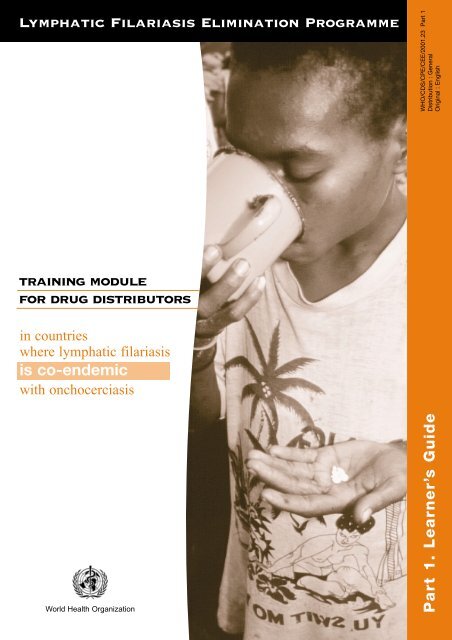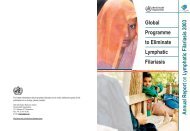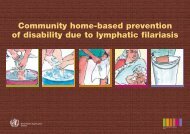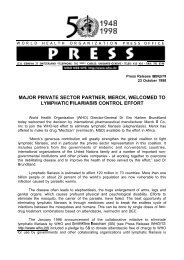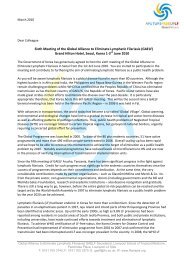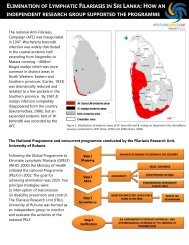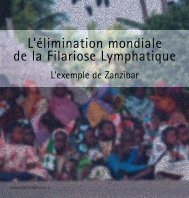Learner's Guide - Global Alliance to Eliminate Lymphatic Filariasis
Learner's Guide - Global Alliance to Eliminate Lymphatic Filariasis
Learner's Guide - Global Alliance to Eliminate Lymphatic Filariasis
You also want an ePaper? Increase the reach of your titles
YUMPU automatically turns print PDFs into web optimized ePapers that Google loves.
<strong>Lymphatic</strong> <strong>Filariasis</strong> Elimination Programme<br />
WHO/CDS/CPE/CEE/2001.23 Part 1<br />
Distribution : General<br />
Original : English<br />
training module<br />
for drug distribu<strong>to</strong>rs<br />
in countries<br />
where lymphatic filariasis<br />
is co-endemic<br />
with onchocerciasis<br />
World Health Organization<br />
Part 1. Learner’s <strong>Guide</strong>
<strong>Lymphatic</strong> <strong>Filariasis</strong> Elimination Programme<br />
training module<br />
for drug distribu<strong>to</strong>rs<br />
In countries<br />
where lymphatic filariasis<br />
is co-endemic<br />
with onchocerciasis<br />
Part 1. Learner’s <strong>Guide</strong><br />
<strong>Lymphatic</strong> <strong>Filariasis</strong> Elimination Programme<br />
Department of Control, Prevention and Eradication (CPE)<br />
Communicable Diseases (CDS)<br />
World Health Organization<br />
Geneva, 2001<br />
I
© World Health Organization, 2001<br />
This document is not a formal publication of the World Health Organization (WHO), and all rights are<br />
reserved by the Organization. This document may, however, be freely reviewed, abstracted, reproduced or<br />
translated, in part or in whole, but not for sale nor for use in conjunction with commercial purposes.<br />
The views expressed in documents by named authors are solely the responsibility of those authors.<br />
II
TABLE OF CONTENTS<br />
LEARNING UNIT<br />
Preface<br />
V<br />
Acknowledgements<br />
VI<br />
Introduction<br />
VII<br />
1 <strong>Lymphatic</strong> <strong>Filariasis</strong> Elimination Programme:<br />
Goal And Strategy 1<br />
2 The Disease 5<br />
3 The Drugs 9<br />
4 Adverse Reactions 13<br />
5 How <strong>to</strong> Address People and What <strong>to</strong> Tell Them 17<br />
6 Messages for the Non-Compliant 21<br />
7 Recording the Data 25<br />
8 Supervision of the Health Worker 27<br />
Further Reading 29<br />
Annex 1 Pro-Forma for Recording Household Members for Mass Drug Administration 31
PREFACE<br />
This training module is intended for drug distribu<strong>to</strong>rs involved in lymphatic<br />
filariasis elimination programmes in countries where onchocerciasis<br />
is co-endemic. It is the first of a series produced by the World<br />
Health Organization <strong>to</strong> assist national programmes with the different<br />
aspects of lymphatic filariasis elimination and is made up of two<br />
separate parts: Part 1 (this part), the Learner’s <strong>Guide</strong>, which comprises<br />
eight learning units containing detailed information on the most effective<br />
way <strong>to</strong> carry out drug distribution within a national lymphatic filariasis<br />
elimination campaign; Part 2, the Tu<strong>to</strong>r’s <strong>Guide</strong>, which addresses<br />
those responsible for conducting training programmes, outlines the<br />
main points <strong>to</strong> be learned and provides guidance and suggestions on<br />
the learning process.<br />
The duration of training using the module should be approximately<br />
8 hours, including 40 minutes each for the pre-and post-test<br />
(see proposed timetable under “Introduction” in Part 2. Tu<strong>to</strong>r’s <strong>Guide</strong>).<br />
V
ACKNOWLEDGEMENTS<br />
This module has been developed by Dr Francesco A. Rio, <strong>Lymphatic</strong><br />
<strong>Filariasis</strong> Elimination Programme, Department of Control,<br />
Prevention and Elimination, Communicable Diseases, World Health<br />
Organization, following a series of meetings at national and<br />
regional level. It has been produced with the financial support<br />
of the Ministry of Health and Welfare, Government of Japan.<br />
Acknowledgement is made <strong>to</strong> Dr Gautam Biswas, Medical<br />
Officer, Mrs R. Besana, Secretary, <strong>Lymphatic</strong> <strong>Filariasis</strong><br />
Elimination, Department of Control Prevention and<br />
Elimination, Communicable Diseases, and Dr Eric Ottesen,<br />
former Project Leader, for their assistance in reviewing and<br />
editing the module.<br />
VI
introduction<br />
Introduction - Learner’s <strong>Guide</strong><br />
Objectives of the Learner’s Module<br />
At the end of the training programme, based on the Learner’s <strong>Guide</strong>,<br />
the learners should be able <strong>to</strong>:<br />
▲ ▲ ▲ ▲ ▲ ▲ ▲ ▲<br />
define the purpose of the national elimination programme<br />
list the principal features of the disease<br />
handle and administer the drugs used in the elimination campaign<br />
describe the exclusion criteria for drug administration<br />
assess and classify possible side-effects of the drugs<br />
maintain accurate records of distribution activities<br />
effectively address people<br />
provide messages for the non-compliant<br />
Control of lymphatic filariasis,<br />
leading <strong>to</strong> its elimination, is<br />
based on two major pillars:<br />
(a) control of transmission<br />
of infection; and<br />
(b) control of the long-term<br />
consequences of the disease.<br />
Drug distribution is one<br />
of the major components<br />
of point (a).<br />
The purpose of this module<br />
is <strong>to</strong> provide background<br />
information for those<br />
involved in drug distribution<br />
and, in particular, health<br />
workers responsible for drug<br />
distribution at community<br />
level in countries where<br />
onchocerciasis is co-endemic.<br />
How this subject will be taught<br />
Tu<strong>to</strong>r and facilita<strong>to</strong>rs<br />
The tu<strong>to</strong>r has wide experience of training, is familiar with the structure of the<br />
national health system and is thus able <strong>to</strong> help learners <strong>to</strong> solve a wide range<br />
of problems.<br />
Facilita<strong>to</strong>rs assist the tu<strong>to</strong>r <strong>to</strong> achieve the objectives outlined above. They<br />
lead the discussions and help learners generally, especially when working in<br />
small groups.<br />
Presentations<br />
Presentations in the form of lectures are usually kept <strong>to</strong> a minimum and each<br />
lecture will be kept as short as possible. The information given in the lectures<br />
is already provided in the <strong>Guide</strong> so there will be little need for the learners <strong>to</strong><br />
take notes. A lecture presentation will usually be combined with a practical<br />
demonstration.<br />
VII
Training Module for Drug Distribu<strong>to</strong>rs<br />
in Countries where <strong>Lymphatic</strong> <strong>Filariasis</strong><br />
is Co-endemic with Onchocerciasis<br />
Learner’s <strong>Guide</strong><br />
introduction<br />
Demonstrations<br />
Demonstrations will be used <strong>to</strong> illustrate and reinforce activities that the learner<br />
will carry out later. A great deal of interaction between the tu<strong>to</strong>r, facilita<strong>to</strong>rs<br />
and learners is expected.<br />
Role play<br />
In a role play exercise the learners are asked <strong>to</strong> pretend <strong>to</strong> be a person in a<br />
situation that might arise during his or her job. For example, the learners may<br />
be asked <strong>to</strong> play the part of a non-compliant villager (e.g. in the case of<br />
Learning Units 5 and 6: “How <strong>to</strong> Address People and What <strong>to</strong> Tell Them” and<br />
“Messages for the Non-Compliant”, respectively). Another learner might<br />
play the part of the drug distribu<strong>to</strong>r and then a member of the group can<br />
discuss what was said and done. Much can be learned from this kind of exercise.<br />
Small group discussion<br />
In this exercise a facilita<strong>to</strong>r leads a discussion on a particular subject. Such<br />
discussions provide good opportunities for the learners <strong>to</strong> give their opinions,<br />
develop ideas and learn from one another.<br />
Use of the Learner’s <strong>Guide</strong><br />
The Learner’s <strong>Guide</strong> provides instruction on drug distribution issues and is<br />
designed <strong>to</strong> enable the learners <strong>to</strong> achieve the objectives stated above. It is<br />
divided in<strong>to</strong> eight chapters called Learning Units, each consisting of a<br />
number of objectives. Learners will achieve the main objectives of the course<br />
by consistently following the tu<strong>to</strong>r’s instructions and through close interaction<br />
with the latter. The learners must have assimilated the knowledge of one unit<br />
before proceeding <strong>to</strong> the next. If they require clarification about any point in<br />
a unit they should ask their tu<strong>to</strong>r or fellow learners.<br />
VIII
Presentation<br />
Learners are expected <strong>to</strong> have read the section of the learning unit <strong>to</strong> be covered<br />
before the start of the session and formal presentation of information will be<br />
limited <strong>to</strong> introduc<strong>to</strong>ry remarks by the tu<strong>to</strong>r at the beginning of each subject.<br />
All the information that the learners will need is contained in the <strong>Guide</strong> so<br />
they will not need <strong>to</strong> take notes.<br />
Evaluation<br />
Evaluation of the learner<br />
The evaluation of individual progress will be carried out by the tu<strong>to</strong>r and by<br />
the learner. It will include:<br />
- spot tests – at regular intervals a series of questions aimed at testing<br />
▲ ▲<br />
the learner’s knowledge will be given by the tu<strong>to</strong>r. They are designed<br />
<strong>to</strong> help the learner and tu<strong>to</strong>r <strong>to</strong> assess the competence gained. Correct<br />
answers will be provided after the spot tests and discussion will take<br />
place <strong>to</strong> ensure that activities requiring further practice are highlighted.<br />
- multiple-choice quizzes – each question is provided with a list of<br />
possible answers from which the learners must select the correct one(s).<br />
At the end of these quizzes it will not be necessary <strong>to</strong> give the answers<br />
<strong>to</strong> each question but the tu<strong>to</strong>r will analyze the results <strong>to</strong> identify <strong>to</strong>pics<br />
that were not clearly unders<strong>to</strong>od.<br />
Evaluation of the training by the learner<br />
By means of a questionnaire distributed at the end of the training course, the<br />
tu<strong>to</strong>r will ask the learners for their opinion of the training activity. It is<br />
important <strong>to</strong> receive this type of feedback for improvement of future training<br />
activities. The learners are able <strong>to</strong> complete the evaluation questionnaire<br />
anonymously if they wish; however, each one should complete it and should<br />
feel free <strong>to</strong> make suggestions for improvements, whether it concerns the<br />
tu<strong>to</strong>r, the course content, the training facilities or all three.<br />
IX
NOTES
LEARNING UNIT 1<br />
Goal and Strategy<br />
Learner’s <strong>Guide</strong><br />
<strong>Lymphatic</strong> <strong>Filariasis</strong> Elimination<br />
Programme: Goal and Strategy<br />
Learning objectives<br />
By the end of this Unit you should be able <strong>to</strong>:<br />
▲ ▲<br />
describe the goal of the Programme <strong>to</strong> <strong>Eliminate</strong> <strong>Lymphatic</strong><br />
<strong>Filariasis</strong> (PELF)<br />
describe the strategy of the Programme <strong>to</strong> <strong>Eliminate</strong><br />
<strong>Lymphatic</strong> <strong>Filariasis</strong> (PELF)<br />
The goal<br />
The goal of the Programme <strong>to</strong> <strong>Eliminate</strong> <strong>Lymphatic</strong> <strong>Filariasis</strong> (PELF) is <strong>to</strong><br />
eliminate lymphatic filariasis as a public health problem by reducing the level<br />
of the disease in populations <strong>to</strong> a point where transmission no longer occurs.<br />
The disease is a major contribu<strong>to</strong>r <strong>to</strong> poverty and disability. The cost of<br />
managing acute and chronic manifestations constitutes an enormous loss of<br />
financial resources resulting in a major obstacle <strong>to</strong> economic development.<br />
Studies are currently underway <strong>to</strong> quantify the costs borne by endemic countries.<br />
<strong>Lymphatic</strong> filariasis is so disfiguring, and the accompanying infections so<br />
distasteful, that people are ashamed <strong>to</strong> go out in public and consequently isolate<br />
themselves from society. People affected by the disease find it difficult <strong>to</strong> get<br />
a job and are often sacked because of their disfigurement or disability. Often,<br />
they do not marry and there is a high rate of separation in couples where one<br />
of the partners has the disease.<br />
The drugs given during<br />
the elimination programme<br />
will spare the next generation<br />
from elephantiasis,<br />
hydrocoele and other<br />
manifestations of lymphatic<br />
filariasis by breaking the<br />
cycle of infection between<br />
mosqui<strong>to</strong>es and humans.<br />
1
Training Module for Drug Distribu<strong>to</strong>rs<br />
in Countries where <strong>Lymphatic</strong> <strong>Filariasis</strong><br />
is Co-endemic with Onchocerciasis<br />
Learner’s <strong>Guide</strong><br />
The drugs given during the elimination programme will spare the next generation<br />
from elephantiasis, hydrocoele and other manifestations of lymphatic<br />
filariasis by breaking the cycle of infection between mosqui<strong>to</strong>es and<br />
humans. As an added benefit of the treatment, the burden of intestinal<br />
parasites will also be significantly reduced in areas where these exist<br />
alongside lymphatic filariasis. Thus, children will grow up healthier, learn<br />
more effectively and play a more active role in the development of their<br />
communities and countries.<br />
The strategy<br />
The strategy of the Programme <strong>to</strong> <strong>Eliminate</strong> <strong>Lymphatic</strong> <strong>Filariasis</strong> is based on:<br />
1) interruption of disease transmission; and<br />
2) treatment of the problems associated with lymphoedema (disability<br />
prevention and control).<br />
1 - Interruption of transmission<br />
The principal approach<br />
for interruption of<br />
transmission is a single-dose<br />
treatment of two drugs given<br />
<strong>to</strong>gether, once a year<br />
for 4-6 years.<br />
The principal approach for interrupting transmission of infection is <strong>to</strong> treat<br />
the entire ‘at risk’ population with a single administration of two drugs given<br />
<strong>to</strong>gether, once yearly for 4-6 years. The goal of such treatment is <strong>to</strong> protect<br />
the next generation from elephantiasis and other manifestations of filarial<br />
disease by breaking the cycle of infection between mosqui<strong>to</strong>es and humans.<br />
Areas in which lymphatic filariasis is endemic must be identified and then<br />
community-wide programmes implemented.<br />
The purpose of treating the affected community is <strong>to</strong> eliminate microfilariae<br />
from the blood of infected individuals so that transmission of the infection by<br />
the mosqui<strong>to</strong> can be interrupted. In countries where onchocerciasis is<br />
co-endemic the programme will be based on the once-yearly administration<br />
of two single-dose drugs given <strong>to</strong>gether: ivermectin plus albendazole.<br />
This yearly, single-dose treatment must be carried out for 4-6 years.<br />
2
Goal and Strategy<br />
Learner’s <strong>Guide</strong><br />
2 - Disability prevention and control<br />
New, effective and simple techniques have been developed <strong>to</strong> alleviate the<br />
suffering caused by acute and chronic manifestations of the disease such as<br />
acute inflamma<strong>to</strong>ry attacks, lymphoedema, hydrocoele and elephantiasis of<br />
the limbs or genitals; secondary infections associated with damaged lymphatics<br />
can now be effectively treated and prevented. These techniques are particularly<br />
effective in preventing painful, debilitating and damaging episodes of<br />
lymphangitis and can even reverse much of the damage already sustained.<br />
They consist of regular washing with soap and water, regular exercising of<br />
the limbs, and other simple activities easily carried out in the home.<br />
It is necessary <strong>to</strong> raise awareness in affected patients and <strong>to</strong> implement as<br />
many community education programmes as possible <strong>to</strong> promote the benefits<br />
of these simple, effective local hygiene measures.<br />
You should read carefully<br />
the next section of this guide<br />
before commencing the session<br />
<strong>to</strong> which it relates.<br />
3
NOTES<br />
4
LEARNING UNIT 2<br />
The Disease<br />
Learner’s <strong>Guide</strong><br />
The Disease<br />
Learning objectives<br />
By the end of this Unit you should be able <strong>to</strong>:<br />
▲ ▲ ▲<br />
describe the cause of lymphatic filariasis<br />
describe how the disease is transmitted<br />
describe some important characteristics of the disease<br />
Elephantiasis has been known and written about since the dawn of civilization.<br />
It was depicted on the pharaonic murals of Egypt and in the ancient medical<br />
texts of China, India, Japan, and Persia. Elephantiasis and hydrocoele were<br />
first associated with parasitic filarial worms and their mosqui<strong>to</strong> vec<strong>to</strong>rs in the<br />
late 19th century by French, English and Australian physicians working with<br />
patients from Cuba, Brazil, China and India.<br />
<strong>Lymphatic</strong> filariasis is caused by thread-like parasitic worms, called filariae.<br />
These filarial parasites, in their adult stage, live in the vessels of the lymphatic<br />
system, the network of nodes and vessels that maintains the fluid balance between<br />
the tissues and the blood, and which is an essential component for the body's<br />
immune defence system. The worms live for 4-6 years, producing millions of<br />
very small larvae - immature microfilariae that circulate in the peripheral<br />
blood with a marked nocturnal or diurnal periodicity.<br />
<strong>Lymphatic</strong> filariasis<br />
is caused by thread-like<br />
parasitic worms,<br />
called filariae.<br />
The life cycle<br />
The disease is transmitted by mosqui<strong>to</strong>es that bite infected humans and pick<br />
up the microfilariae from the blood. The microfilariae ingested by the mosqui<strong>to</strong><br />
pass <strong>to</strong> the s<strong>to</strong>mach, then penetrate the gut wall, enter the body cavity and<br />
then the thoracic muscle. After a period of approximately two weeks the parasites<br />
migrate <strong>to</strong> the head of the mosqui<strong>to</strong> and position themselves in the mouth<br />
parts ready <strong>to</strong> enter the punctured skin of the next individual when the mosqui<strong>to</strong><br />
bites, thus completing the cycle.<br />
Microfilaria in the blood<br />
Macrofilaria, the adult stage<br />
5
Training Module for Drug Distribu<strong>to</strong>rs<br />
in Countries where <strong>Lymphatic</strong> <strong>Filariasis</strong><br />
is Co-endemic with Onchocerciasis<br />
Learner’s <strong>Guide</strong><br />
Mosqui<strong>to</strong> takes<br />
a blood meal<br />
infecting a person<br />
Larvae develop<br />
in<strong>to</strong> adult worms<br />
in lymphatic vessels<br />
Bood microfilariae<br />
ingested by<br />
mosqui<strong>to</strong> during<br />
a blood meal<br />
Adult female worms<br />
produce microfilariae<br />
which migrate <strong>to</strong><br />
peripheral blood<br />
Acute inflamma<strong>to</strong>ry attack<br />
Clinical features<br />
There are acute and chronic manifestations of lymphatic filariasis.<br />
Acute manifestations<br />
Signs of a recent acute attack:<br />
peeling of the skin<br />
(pho<strong>to</strong>graphs provided by courtesy of Dr G. Dreyer,<br />
Federal University of Pernambuco, Recife, Brazil)<br />
Acute inflamma<strong>to</strong>ry attacks are the most important type of acute manifestations<br />
of the disease. They are characterized by local symp<strong>to</strong>ms such as swelling,<br />
warmth, redness, and extreme pain of the affected area, and general<br />
symp<strong>to</strong>ms such as fever, chills, headache and weakness. Such symp<strong>to</strong>ms<br />
occur in the limbs or in the scrotum, and are related <strong>to</strong> bacterial or fungal<br />
superinfection.<br />
Local symp<strong>to</strong>ms of acute<br />
attack are swelling,<br />
warmth, redness,<br />
and extreme pain of<br />
the affected area;<br />
general symp<strong>to</strong>ms<br />
are fever, chills, headache<br />
and weakness.<br />
Inflammation during the acute attack damages the tiny lymph vessels in the<br />
skin and reduces their ability <strong>to</strong> drain fluid from the skin. Inflammation also<br />
damages the skin. As the damage is repaired, the skin becomes hard in a process<br />
known as fibrosis. With each acute attack, the skin grows harder. A vicious<br />
cycle begins as the chronic swelling predisposes the skin <strong>to</strong> bacterial infection.<br />
6
The Disease<br />
Learner’s <strong>Guide</strong><br />
Chronic manifestations<br />
Lymphoedema and urogenital manifestation are chronic manifestations of the<br />
disease. Lymphoedema is due <strong>to</strong> lymphatic dysfunction caused by the presence<br />
of the adult worm. It occurs more frequently in the lower extremities, but can<br />
also affect the breast, scrotum, penis, arms and less frequently, the vulva.<br />
Haematuria and chyluria<br />
The chronic manifestations of lymphatic filariasis comprise haematuria (presence<br />
of blood in the urine), hydrocoele (collection of fluid inside the scrotal sac),<br />
chylocoele (presence of lymph in the cavity of the tunica vaginalis), chyluria<br />
(presence of lymphatic fluid in the urine, which gives the urine a characteristic<br />
milky aspect), and lymphoedema of the scrotum or the penis.<br />
The global burden<br />
It is estimated that 120 million people in more than 80 countries throughout<br />
the tropics and sub-tropics are infected by the disease. One-third of those<br />
infected live in India, one third in Africa and the remainder in South-Asia, the<br />
Pacific and the Americas.<br />
Elephantiasis of the leg<br />
120 million people<br />
in more than<br />
80 countries<br />
are infected<br />
by the disease<br />
In tropical and subtropical areas where lymphatic filariasis is well-established,<br />
the prevalence of infection continues <strong>to</strong> increase. A primary cause of this<br />
increase is the rapid and unplanned growth of cities, which creates numerous<br />
breeding sites for the mosqui<strong>to</strong>es that transmit the disease. <strong>Lymphatic</strong> filariasis<br />
is a major cause of disability, social stigma, reduced psychosocial and economic<br />
opportunities, and is a major burden on health and hospital resources,<br />
particularly as a result of the costs of surgical intervention.<br />
You should read carefully<br />
the next section of this guide<br />
before commencing the session<br />
<strong>to</strong> which it relates.<br />
7
Training Module for Drug Distribu<strong>to</strong>rs<br />
in Countries where <strong>Lymphatic</strong> <strong>Filariasis</strong><br />
is Co-endemic with Onchocerciasis<br />
Learner’s <strong>Guide</strong><br />
Distribution of lymphatic filariasis<br />
endemic countries<br />
post-endemic or uncertain<br />
non-endemic<br />
8
LEARNING UNIT 3<br />
The Drugs<br />
Learner’s <strong>Guide</strong><br />
The Drugs<br />
Learning objectives<br />
By the end of this Unit you should be able <strong>to</strong>:<br />
▲ ▲ ▲ ▲ ▲ ▲<br />
understand the principle underlying the elimination strategy<br />
list the drugs used in the elimination programme in your country<br />
specify the dosage of both drugs<br />
describe how <strong>to</strong> administer both drugs<br />
describe how <strong>to</strong> handle both drugs<br />
identify who should be excluded from drug distribution<br />
The strategy<br />
To interrupt the transmission of lymphatic filariasis (LF) in countries where<br />
onchocerciasis is co-endemic, community-wide (“mass treatment”) programmes<br />
will be implemented in LF-endemic areas. The aim of this approach is <strong>to</strong><br />
eliminate the microfilariae from the blood of infected individuals so that<br />
transmission of the infection by the mosqui<strong>to</strong> can be blocked.<br />
The elimination programme will be based on once-yearly administration of<br />
two single-dose drugs given <strong>to</strong>gether: ivermectin plus albendazole. This yearly,<br />
single-dose treatment will be carried out for 4-6 years, until the adult worms<br />
in the body have come <strong>to</strong> the end of their normal life span.<br />
The duration of the programme will depend on the coverage achieved. Low<br />
coverage will result in persistent residual transmission and therefore, annual<br />
treatment may need <strong>to</strong> continue for a longer period <strong>to</strong> ensure complete<br />
interruption of transmission. Consequently, if the microfilarial prevalence in<br />
the population is <strong>to</strong> be lowered <strong>to</strong> levels where transmission of LF is no longer<br />
possible, it is vital <strong>to</strong> achieve a high level of coverage.<br />
9
Training Module for Drug Distribu<strong>to</strong>rs<br />
in Countries where <strong>Lymphatic</strong> <strong>Filariasis</strong><br />
is Co-endemic with Onchocerciasis<br />
Learner’s <strong>Guide</strong><br />
The drugs used<br />
Community-wide treatment, once-yearly, with a single-dose, 2-drug regimen<br />
The ingestion<br />
of the drugs should<br />
always be supervised<br />
by the person<br />
administering the drug.<br />
in tablet form:<br />
- ivermectin 150 µg/kg - plus<br />
- albendazole, 400 mg - same dose for all ages<br />
Both drugs are administered at the same time under supervision<br />
Ivermectin<br />
Colour: off-white<br />
Shape: round-shaped tablet, embossed with “MSD” on one side and “32”<br />
on the other<br />
Presentation: packaged in containers of 500 tablets<br />
Dosage: 150 µg/kg. The dosage is determined by the patient’s height, as follows:<br />
Bodyheight (cm)<br />
less than 90<br />
Dose (number of tablets)<br />
no tablets<br />
90 <strong>to</strong> 119<br />
120 <strong>to</strong> 140<br />
141 <strong>to</strong> 158<br />
more than 158<br />
In some communities, measuring height with a stick is associated with death.<br />
To overcome this popular belief, marking a wall may be an acceptable alternative.<br />
How <strong>to</strong> administer it: tablets should be swallowed with water. They have a<br />
bitter taste. The ingestion of the drugs should always be supervised by the<br />
person administering the drug.<br />
How <strong>to</strong> handle it: keep the container tightly closed, in a dry place,<br />
protected from light. S<strong>to</strong>re below 30ºC. The shelf life of ivermectin is 24<br />
months but only 13 months after the bottle is opened.<br />
10
The Drugs<br />
Learner’s <strong>Guide</strong><br />
Albendazole<br />
Colour: off-white<br />
Shape: 400 mg tablet, oval-shaped, embossed with “ALB 400” on one side<br />
Presentation: packaged in containers of 100 tablets<br />
Dosage: 400 mg (one tablet)<br />
How <strong>to</strong> administer it: tablets are chewable and have a pleasant taste (passion<br />
fruit). The ingestion of the drugs should always be supervised by the<br />
person administering the drug.<br />
How <strong>to</strong> handle it: keep the container tightly closed, in a dry place and<br />
protected from light. S<strong>to</strong>re below 30ºC. The shelf life of albendazole is 5 years.<br />
Why use two drugs?<br />
The two-drug regimen is more effective than the single-drug regimen for<br />
long-term reduction (more than one year) of microfilarial density and<br />
prevalence.<br />
Exclusion criteria<br />
Endemic populations eligible for community-wide treatment with ivermectin<br />
and albendazole co-administration should include everyone with the exception of :<br />
- sick individuals;<br />
- children under 15 kg in weight or less than 90 cm height<br />
(corresponds <strong>to</strong> 5 years of age);<br />
- pregnant women and lactating women within 1 week of birth.<br />
Please note that, since there is no direct or anecdotal evidence of complications<br />
resulting from treatment with single doses of either of these drugs in pregnant<br />
women, in the absence of definitive information, exclusion related <strong>to</strong><br />
pregnancy is a precaution.<br />
The two-drug regimen<br />
is more effective than<br />
the single-drug regimen.<br />
You should read carefully<br />
the next section of this guide<br />
before commencing the session<br />
<strong>to</strong> which it relates.<br />
11
LEARNING UNIT 4<br />
Adverse Reactions<br />
Learner’s <strong>Guide</strong><br />
Adverse Reactions<br />
Learning objectives<br />
By the end of this Unit you should be able <strong>to</strong>:<br />
▲ ▲<br />
list possible adverse reactions, both systemic and localized<br />
understand the principle underlying the management<br />
of adverse reactions<br />
Ivermectin and albendazole, the drugs recommended for use by national<br />
elimination programmes in countries where onchocerciasis is co-endemic, are<br />
extremely safe when administered individually as a single-dose.<br />
Practical field experience with each has extended <strong>to</strong> tens of millions<br />
(ivermectin) or hundreds of millions (albendazole) of people treated during<br />
the past 20 years. At the recommended once-yearly dosages (ivermectin:<br />
150 µg/kg; albendazole: 400 mg) essentially no <strong>to</strong>xic reactions <strong>to</strong> the drugs<br />
have been noted, and recent studies have confirmed that co-administration of<br />
these drugs does not enhance their <strong>to</strong>xicity.<br />
Adverse reactions<br />
Ivermectin and albendazole are both safe and well-<strong>to</strong>lerated drugs. Adverse<br />
reactions do sometimes occur following treatment, especially with ivermectin,<br />
primarily as a result of the individual’s immune inflamma<strong>to</strong>ry response <strong>to</strong><br />
dying parasites; the greater the microfilarial load in the patient, the greater<br />
are the frequency and severity of such reactions. Adverse reactions are usually<br />
self-limited and go away without any action, although symp<strong>to</strong>matic treatment<br />
with analgesics or antipyretics is helpful.<br />
Adverse reactions<br />
are usually self-limited<br />
and go away without<br />
any action.<br />
Only rarely, in heavily infected individuals, or in people who have his<strong>to</strong>ries<br />
of adenolymphangitis, are these post-treatment adverse reactions severe or do<br />
they require more than just symp<strong>to</strong>matic treatment. Local adverse reactions<br />
are less common and tend <strong>to</strong> occur later (1-2 weeks after treatment) and last<br />
longer.<br />
13
Training Module for Drug Distribu<strong>to</strong>rs<br />
in Countries where <strong>Lymphatic</strong> <strong>Filariasis</strong><br />
is Co-endemic with Onchocerciasis<br />
Learner’s <strong>Guide</strong><br />
There are two groups of adverse reactions, general or local.<br />
General reactions<br />
and fever are positively<br />
associated with the<br />
prevalence and intensity<br />
of microfilaraemia.<br />
General adverse reactions<br />
General adverse reactions and fever are positively associated with the level<br />
and intensity of microfilaraemia. Reactions occur early during the treatment<br />
and generally do not last more than 3 days.<br />
General adverse reactions, in decreasing order of frequency, are:<br />
- headache<br />
- body ache<br />
- fever<br />
- dizziness<br />
- decreased appetite<br />
- malaise<br />
- nausea<br />
- urticaria (itching)<br />
- vomiting<br />
- wheezing and<br />
- bronchial asthma<br />
General reactions and fever are positively associated with the prevalence and<br />
intensity of microfilaraemia.<br />
Local adverse reactions<br />
The most common local reactions are scrotal nodules due <strong>to</strong> death of the<br />
adult worm. Others include, in decreasing order of frequency:<br />
- lymphadenitis (inflammation of a lymph node)<br />
- funiculitis (inflammation of the spermatic chord)<br />
- epididymitis (inflammation of the epididymus, the structure in the duct<br />
where sperma<strong>to</strong>zoa are s<strong>to</strong>red)<br />
- lymphangitis (inflammation of a lymphatic vessel)<br />
- orchalgia (pain in the testicle)<br />
- abscess formation, ulceration or transient lymphoedema (rare)<br />
14
Adverse Reactions<br />
Learner’s <strong>Guide</strong><br />
Management of adverse reactions<br />
The most important principle underlying the management of adverse reactions<br />
is that the community should be informed in advance of the possibility<br />
that such reactions can occur, and primarily in those individuals with moderate<br />
<strong>to</strong> heavy infection in whom parasites are being killed by the drugs.<br />
Equally important is access <strong>to</strong>, and provision of, appropriate medical care<br />
for all those who need it following the administration of the drugs.<br />
Drug distribu<strong>to</strong>rs and health workers should be able <strong>to</strong> reassure patients with<br />
mild adverse reactions and should refer those with severe adverse reactions<br />
<strong>to</strong> designated treatment facilities and, if necessary, help them <strong>to</strong> reach those<br />
facilities.<br />
Health centres and local practitioners should be familiar with the symp<strong>to</strong>ms<br />
that might occur and should be prepared <strong>to</strong> administer treatment, either<br />
palliative (e.g., paracetamol, phenergan) or therapeutic (e.g., intravenous<br />
fluids, cortisone).<br />
The most important<br />
principle underlying<br />
the management of<br />
adverse reactions is that<br />
the community should be<br />
informed in advance<br />
of the possibility that<br />
such reactions can occur.<br />
Moni<strong>to</strong>ring and reporting of adverse reactions<br />
Improper management of adverse reactions can lead <strong>to</strong> an adverse impact on,<br />
and response <strong>to</strong>, the programme, therefore, measures should be taken <strong>to</strong>:<br />
- forewarn the community that some adverse reactions will be encountered<br />
in some individuals;<br />
- inform the community and their leaders of places where they can obtain<br />
help, if required, in the event of adverse reactions;<br />
- identify health centres with facilities for treating adverse reactions;<br />
- inform local practitioners how <strong>to</strong> treat patients who may report <strong>to</strong> them<br />
with adverse reactions.<br />
You should read carefully<br />
the next section of this guide<br />
before commencing the session<br />
<strong>to</strong> which it relates.<br />
15
NOTES<br />
16
LEARNING UNIT 5<br />
How <strong>to</strong> Address People and What <strong>to</strong> Tell Them<br />
Learner’s <strong>Guide</strong><br />
How <strong>to</strong> Address People<br />
and What <strong>to</strong> Tell Them<br />
Learning objectives<br />
By the end of this Unit you should be able <strong>to</strong>:<br />
▲ ▲<br />
evaluate the value of positive interaction with people<br />
choose appropriate ways <strong>to</strong> communicate with people receiving<br />
drugs during the elimination campaign<br />
Your personality has an important part <strong>to</strong> play in your interaction with<br />
people. Most of us have <strong>to</strong> operate with the personality we have because it is<br />
difficult, and probably not desirable <strong>to</strong> change. However, everyone should be<br />
able <strong>to</strong> create a friendly atmosphere when interacting with people.<br />
People should be presented with information that they can understand. Facts<br />
should be presented in words with which people are familiar, and facts should<br />
be relevant <strong>to</strong> them. In the case of lymphatic filariasis you may have <strong>to</strong><br />
present the disease <strong>to</strong> villagers, explain the importance of taking the drugs <strong>to</strong><br />
interrupt the transmission of the disease, describe the exclusion criteria,<br />
explain what adverse reactions might occur as a result of taking the drugs,<br />
provide details on what <strong>to</strong> do in the event of adverse reactions, and more<br />
generally, pass <strong>to</strong> the community a positive message about the lymphatic<br />
filariasis elimination campaign.<br />
When presenting<br />
information <strong>to</strong> people<br />
you should use familiar<br />
words <strong>to</strong> introduce<br />
unfamiliar information.<br />
17
Training Module for Drug Distribu<strong>to</strong>rs<br />
in Countries where <strong>Lymphatic</strong> <strong>Filariasis</strong><br />
is Co-endemic with Onchocerciasis<br />
Learner’s <strong>Guide</strong><br />
You should realize that the health worker:<br />
- has a scientific attitude <strong>to</strong>wards lymphatic filariasis and other diseases<br />
- uses medical and scientific terms<br />
- is accus<strong>to</strong>med <strong>to</strong> receiving technical information<br />
Whereas the villager:<br />
- fears the illness in general<br />
- does not understand most of the medical and scientific terminology used<br />
- is concerned about being well and may not wish <strong>to</strong> talk about diseases<br />
- may be a person with little or no education<br />
When presenting information <strong>to</strong> people you should:<br />
- use familiar words <strong>to</strong> introduce unfamiliar information<br />
- use examples and comparisons<br />
- present the messages clearly, without distracting those addressed with<br />
irrelevant details<br />
18
How <strong>to</strong> Address People and What <strong>to</strong> Tell Them<br />
Learner’s <strong>Guide</strong><br />
When interacting with people you should:<br />
- greet them<br />
- establish good relationships<br />
- smile and be pleasant<br />
- use appropriate vocabulary<br />
- be confident, polite and approach them with warmth<br />
- praise them for what they do correctly<br />
- avoid arrogant behaviour<br />
- avoid insults or sarcasm<br />
- do not refuse hospitality, but before accepting an invitation for a chat or a<br />
cup of tea, coffee or water, make it clear that you have other people <strong>to</strong> meet<br />
during your working day<br />
At the first meeting with the community leader you should give an overview<br />
of the programme in clear and concise terms. Explain carefully and clearly:<br />
- that the drugs are free – they should never be sold or paid for<br />
- that certain people will be given the drug while others will not, and why<br />
- what is expected of the community<br />
- what the community will gain from the drug distribution<br />
You should read carefully<br />
the next section of this guide<br />
before commencing the session<br />
<strong>to</strong> which it relates.<br />
19
NOTES<br />
20
LEARNING UNIT 6<br />
Messages for the Non-Compliant<br />
Learner’s <strong>Guide</strong><br />
Messages for the Non-Compliant<br />
Learning objectives<br />
By the end of this Unit you should be able <strong>to</strong>:<br />
▲ ▲<br />
reassure people who may be reluctant <strong>to</strong> accept the drugs<br />
distributed during the National Programme <strong>to</strong> <strong>Eliminate</strong><br />
<strong>Lymphatic</strong> <strong>Filariasis</strong><br />
emphasize the importance of treating as many people as possible<br />
As stated in Learning Unit 1, one of the principles of the strategy of the<br />
Programme <strong>to</strong> <strong>Eliminate</strong> <strong>Lymphatic</strong> <strong>Filariasis</strong> is the interruption of transmission<br />
of infection through treatment of the entire at-risk population with a single<br />
administration of two drugs given <strong>to</strong>gether once a year for 4-6 years. Thus,<br />
it is critical <strong>to</strong> provide drugs <strong>to</strong> the largest number of people possible in the<br />
endemic areas.<br />
It is critical <strong>to</strong> provide<br />
drugs <strong>to</strong> the largest<br />
number of people.<br />
By the time you are involved in drug distribution, a media campaign <strong>to</strong> raise<br />
peoples’ awareness of the purpose of the programme will have taken place.<br />
Nevertheless, some of the villagers may refuse <strong>to</strong> take the drugs for a series<br />
of different reasons some of which are given below:<br />
21
Training Module for Drug Distribu<strong>to</strong>rs<br />
in Countries where <strong>Lymphatic</strong> <strong>Filariasis</strong><br />
is Co-endemic with Onchocerciasis<br />
“<br />
Learner’s <strong>Guide</strong><br />
- I feel well, so I don’t need <strong>to</strong> take the drugs.<br />
- If I need drugs I will go <strong>to</strong> see the doc<strong>to</strong>r.<br />
- How do you know that I am sick/that I need drugs?<br />
- Why were people in the village next <strong>to</strong> us not treated?<br />
- I don’t want <strong>to</strong> take the drugs, I heard that they will make you sick.<br />
- Why don’t you want <strong>to</strong> give the drugs <strong>to</strong> my little boy/girl?<br />
- I haven’t heard anything about this disease/elimination programme.<br />
- Leave the drugs here I will take them another day.<br />
- Leave the drugs with me, I will give the tablets <strong>to</strong> him/her later on during<br />
the week.<br />
- I know somebody with a big swollen leg who <strong>to</strong>ok the drug and nothing<br />
happened. Your drug can’t work very well.<br />
- How do you know I am not allergic <strong>to</strong> the drugs?<br />
- I never take drugs.<br />
- Are you sure it’s not against our religion?<br />
- I am not able <strong>to</strong> swallow tablets that big.<br />
You should be able <strong>to</strong> convince people that the drugs are safe, that any<br />
problems that might arise would be minor (see Learning Unit 5), and that<br />
such problems usually disappear very quickly. Reassure people that the<br />
medical services will be available <strong>to</strong> treat any complication that may arise.<br />
”<br />
You should be able<br />
<strong>to</strong> convince people<br />
that the drugs are safe<br />
(see Learning Unit 5).<br />
22
Messages for the Non-Compliant<br />
Learner’s <strong>Guide</strong><br />
You should explain about the exclusion criteria (see Learning Unit 3).<br />
Pregnant women, children less than 90 cm in height (under 5 years of age)<br />
and the very sick should not be treated. Explain <strong>to</strong> the people that this shows<br />
how much the health authorities care about peoples’ health.<br />
Explain about<br />
the exclusion criteria<br />
see Learning Unit 3.<br />
Another important point that you may want <strong>to</strong> clarify is that the drugs are not<br />
intended <strong>to</strong> cure the chronic effects of lymphatic filariasis. In other words,<br />
people who are already affected by the disease (for example whose limbs are<br />
swollen) will have <strong>to</strong> live with their condition. However, there are methods<br />
<strong>to</strong> improve their way of life and <strong>to</strong> greatly decrease their suffering.<br />
Another important point<br />
that you may want <strong>to</strong><br />
clarify is that the drugs<br />
are not intended <strong>to</strong> cure<br />
the chronic effects<br />
of lymphatic filariasis.<br />
It is also vital <strong>to</strong> explain that, even if a person feels well, he or she may be<br />
infected by the parasite and at risk of developing the disease. Furthermore,<br />
this person will still carry parasites that may be spread <strong>to</strong> others through the<br />
mosqui<strong>to</strong>. Stress the fact that, by taking the drugs, the parasites inside<br />
peoples’ bodies will be killed and that, consequently, mosqui<strong>to</strong>es will no longer<br />
spread the disease. Explain that the next generation will be free of the disease.<br />
If people find albendazole tablets <strong>to</strong>o big <strong>to</strong> swallow, explain that they can be<br />
chewed and that they are pleasantly flavoured.<br />
You should read carefully<br />
the next section of this guide<br />
before commencing the session<br />
<strong>to</strong> which it relates.<br />
23
NOTES<br />
24
LEARNING UNIT 7<br />
Recording data<br />
Learner’s <strong>Guide</strong><br />
Recording Data<br />
Learning objectives<br />
By the end of this Unit you should be able <strong>to</strong>:<br />
▲ ▲ ▲<br />
describe the significance of recording data<br />
describe the data flow within the record-keeping system<br />
of the National Programme <strong>to</strong> <strong>Eliminate</strong> <strong>Lymphatic</strong> <strong>Filariasis</strong><br />
correctly complete the forms that you will use during<br />
drug distribution<br />
Supply and re-supply <strong>to</strong> the National Programme <strong>to</strong> <strong>Eliminate</strong> <strong>Lymphatic</strong><br />
<strong>Filariasis</strong> with drugs cannot be guaranteed if adequate record-keeping is not<br />
carried out. A good system of record-keeping is essential for the smooth<br />
running of the programme. It should include the following elements:<br />
- numbers of persons treated and retreated<br />
- identification and re-identification of persons treated<br />
- round of treatment received<br />
- drug tablet inven<strong>to</strong>ry<br />
- movement of personnel and vehicles, where appropriate<br />
Recording forms are at the heart of the supply information system. They are<br />
documents that move from one level <strong>to</strong> another, carrying specific information<br />
about drug needs, drug movements, and associated financial transactions.<br />
Copies of recording forms, filed at various points of the distribution network,<br />
form the audit trail for tracing the flow of the drugs. The forms should be<br />
filled in regularly and accurately. They are used <strong>to</strong> communicate supply<br />
needs, consumption data and other relevant information pertinent <strong>to</strong> the health<br />
system.<br />
You should draw a scheme of the record-keeping system of the National<br />
Programme <strong>to</strong> <strong>Eliminate</strong> <strong>Lymphatic</strong> <strong>Filariasis</strong> in your country and discuss it<br />
with the participants during your training.<br />
A sample of a pro-forma for recording house-hold members for mass drug<br />
distribution is given in Annex 1, at the end of this training module.<br />
You should read carefully<br />
the next section of this guide<br />
before commencing the session<br />
<strong>to</strong> which it relates.<br />
25
NOTES<br />
26
LEARNING UNIT 8<br />
Supervision of the Health Worker<br />
Learner’s <strong>Guide</strong><br />
Supervision of the Health Worker<br />
Learning objectives<br />
By the end of this Unit you should be able <strong>to</strong>:<br />
▲ ▲ ▲<br />
understand why supervision of your work is necessary<br />
be aware that supervision can be carried<br />
out in a number of ways<br />
understand what you must do <strong>to</strong> help your supervisor<br />
in his or her job<br />
The need for supervision<br />
Supervision is necessary for a number of reasons:<br />
- it confirms that you are doing your job in the way you have been trained <strong>to</strong> do<br />
- it enables you <strong>to</strong> make minor but necessary corrections <strong>to</strong> your working<br />
methods<br />
- it should indicate whether you need retraining or whether you are suitable<br />
for more advanced training<br />
- it provides a good opportunity for you <strong>to</strong> discuss with your supervisor any<br />
difficulties you may be having with your work<br />
Types of supervision<br />
There are two basic types of supervision: direct and indirect.<br />
Direct supervision<br />
In the case of direct supervision, your supervisor is able <strong>to</strong> be in constant<br />
<strong>to</strong>uch with you over a period of time. That period may be a single day, if your<br />
supervisor is visiting your place of work, or longer. The supervisor is able <strong>to</strong><br />
see what you do in your job and how you do it. You have the opportunity <strong>to</strong><br />
discuss important aspects of your work, and this is helpful <strong>to</strong> both of you.<br />
27
Training Module for Drug Distribu<strong>to</strong>rs<br />
in Countries where <strong>Lymphatic</strong> <strong>Filariasis</strong><br />
is Co-endemic with Onchocerciasis<br />
Learner’s <strong>Guide</strong><br />
Indirect supervision<br />
In the case of indirect supervision, the supervisor is only able <strong>to</strong> judge how<br />
well you are working from the records that you submit regularly. However,<br />
the supervisor needs <strong>to</strong> see how you are dealing with the distribution of<br />
drugs, how correctly you are identifying the villagers who should be excluded<br />
from drug distribution, and may also want <strong>to</strong> know how many people are<br />
refusing the drugs and how you deal with them. For this reason it is critical<br />
that all forms and reports you compile are well organized, complete and<br />
up-<strong>to</strong>-date. Forms and reports that are disorganized, incomplete and out-ofdate<br />
project a poor image of your professional performance, and do not allow<br />
the system <strong>to</strong> function correctly.<br />
28
Further reading<br />
<strong>Lymphatic</strong> <strong>Filariasis</strong>. WHO Fact Sheet No. 102<br />
The Programme <strong>to</strong> <strong>Eliminate</strong> <strong>Lymphatic</strong> <strong>Filariasis</strong> (PELF), WHO, Geneva<br />
The Programme <strong>to</strong> <strong>Eliminate</strong> <strong>Lymphatic</strong> <strong>Filariasis</strong>. Essential Elements for Medical<br />
Personnel in Onchocerciasis Co-Endemic Countries (WHO/CDS/CPE/CEE/2000.13),<br />
WHO, Geneva<br />
Ready for <strong>Global</strong> Elimination (WHO/CDS/CPE/CEE/2000.2), WHO, Geneva<br />
Weekly Epidemiological Record No. 20, 2001, 76, 149-156<br />
More documents and information are available at the following address:<br />
CDS Information Resource Centre<br />
World Health Organization<br />
1211 Geneva 27, Switzerland<br />
fax: +41 22 791 42 85<br />
e-mail: cdsdoc@who.int<br />
and on the following websites:<br />
http://www.who.int/ctd/filariasis/home<br />
http://www.filariasis.org<br />
29
NOTES<br />
30
Annex 1<br />
Pro-forma for recording household<br />
members for mass drug administration<br />
1. State/Region . . . . . . . . . . . . . . . . . . . . . . . . . . . . . . . . . . . . . . . . . . . . . . . . . . . . . . . . . . . . . . . . . . . . . .<br />
2. Implementation Unit . . . . . . . . . . . . . . . . . . . . . . . . . . . . . . . . . . . . . . . . . . . . . . . . . . . . . . . . . . . . . . . .<br />
3. Au<strong>to</strong>nomous Community/Village . . . . . . . . . . . . . . . . . . . . . . . . . . . . . . . . . . . . . . . . . . . . . . . . . . . . . . .<br />
4. Ward . . . . . . . . . . . . . . . . . . . . . . . . . . . . . . . . . . . . . . . . . . . . . . . . . . . . . . . . . . . . . . . . . . . . . . . . . . . .<br />
5. Household identifier . . . . . . . . . . . . . . . . . . . . . . . . . . . . . . . . . . . . . . . . . . . . . . . . . . . . . . . . . . . . . . . .<br />
Details of household members and his<strong>to</strong>ry of receiving ivermectin and albendazole<br />
S. Name Relation <strong>to</strong> head of household Age Sex Treatment Date Number<br />
No. (surname/family name) (years) (m/f) received (y/n) received of<br />
reasons for not tablets<br />
taking (code*) (S/L) @<br />
1.<br />
2.<br />
3.<br />
4.<br />
5.<br />
6.<br />
7.<br />
8.<br />
9.<br />
10.<br />
11.<br />
12.<br />
13.<br />
14.<br />
15.<br />
16.<br />
17.<br />
18.<br />
19.<br />
20.<br />
21.<br />
22.<br />
23.<br />
24.<br />
25.<br />
26.<br />
27.<br />
28.<br />
29.<br />
30.<br />
Note: List should include all the members of the household even if they did not receive or refused the drugs<br />
* Code for reasons for not taking drugs: 1-Pregnant; 2-Lactating; 3-Sick; 4-No knowledge; 5-Not present; 6-Did not receive; 9-Others<br />
@ S- small tablets (ivermectin) L-large tablets (albendazole)<br />
31


